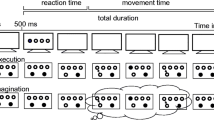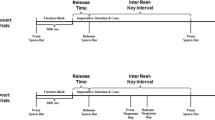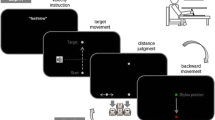Abstract
In motor imagery, probably several inhibitory mechanisms prevent actual movements: global inhibition, effector-specific inhibition, and inhibition retrieved during target processing. We investigated factors that may influence those mechanisms. In an action mode switching paradigm, participants imagined and executed movements from home buttons to target buttons. We analysed sequential effects. Activation (due to execution) or inhibition (due to imagination) in the previous trial should affect performance in the subsequent trial, enabling conclusions about inhibitory mechanisms in motor imagery. In Experiment 1, evidence for global and effector-specific inhibition was observed. Evidence for inhibition retrieved during target processing was inconclusive. Data patterns were similar when start and end of the imagined movements were indicated with an effector that was part of the imagined movement (hand) and with a different effector (feet). In Experiment 2, we ruled out that the use of biological stimuli (left/right hands in Experiment 1) to indicate the effector causes sequential effects attributed to effector-specific inhibition, by using uppercase letters (R, L). As in Experiment 1, evidence for effector-specific inhibition was observed. In conclusion, we could reliably disentangle several inhibitory mechanisms in motor imagery.







Similar content being viewed by others
Notes
In execution trials of the foot group we have data from the release and press of the foot buttons and from the release and press of the home buttons. We compared the data from foot buttons and home buttons for RTs and MTs. No significant differences between the data from foot buttons and home buttons were observed. In imagination trials of the foot group the home buttons were not released. Thus, we used the data from foot buttons to calculate RTs and MTs in all conditions to ensure comparability between imagination and execution.
References
Adam, J. J., & Koch, I. (2014). Response-repetition effects depend on motor set: Evidence for anatomical coding in response selection. Human Movement Science, 33, 172–184.
Alkadhi, H., Brugger, P., Boendermaker, S. H., Crelier, G., Curt, A., Hepp-Reymond, M. C., et al. (2005). What disconnection tells about motor imagery: Evidence from paraplegic patients. Cerebral Cortex, 15(2), 131–140.
Aron, A. R., & Verbruggen, F. (2008). Stop the presses: Dissociating a selective from a global mechanism for stopping. Psychological Science, 19(11), 1146–1153.
Bertelson, P. (1965). Serial choice reaction-time as a function of response versus signal-and-response repetition. Nature, 206, 217–218.
Berthoz, A. (1996). The role of inhibition in the hierarchical gating of executed and imagined movements. Cognitive Brain Research, 3(2), 101–113.
Boisgontier, M. P., Wittenberg, G. F., Fujiyama, H., Levin, O., & Swinnen, S. P. (2014). Complexity of central processing in simple and choice multilimb reaction-time tasks. PLoS ONE, 9(2), e90457.
Brass, M., Bekkering, H., Wohlschläger, A., & Prinz, W. (2000). Compatibility between observed and executed finger movements: comparing symbolic, spatial, and imitative cues. Brain and Cognition, 44(2), 124–143.
Brunamonti, E., Ferraina, S., & Paré, M. (2012). Controlled movement processing: Evidence for a common inhibitory control of finger, wrist, and arm movements. Neuroscience, 215, 69–78.
Chan, A. H., & Chan, K. W. (2010). Three-dimensional spatial stimulus–response (S–R) compatibility for visual signals with hand and foot controls. Applied Ergonomics, 41(6), 840–848.
Coxon, J. P., Stinear, C. M., & Byblow, W. D. (2007). Selective inhibition of movement. Journal of Neurophysiology, 97(3), 2480–2489.
Dahm, S. F., & Rieger, M. (2016a). Is there symmetry in motor imagery? Exploring different versions of the mental chronometry paradigm. Attention, Perception, & Psychophysics, 78(6), 1794–1805.
Dahm, S. F., & Rieger, M. (2016b). Cognitive constraints on motor imagery. Psychological Research Psychologische Forschung, 80(2), 235–247.
De Jong, R., Coles, M. G., Logan, G. D., & Gratton, G. (1990). In search of the point of no return: the control of response processes. Journal of Experimental Psychology: Human Perception and Performance, 16(1), 164–182.
Decety, J., & Grèzes, J. (1999). Neural mechanisms subserving the perception of human actions. Trends in Cognitive Sciences, 3(5), 172–178.
Decety, J., & Jeannerod, M. (1996). Mentally simulated movements in virtual reality: does Fitt's law hold in motor imagery? Behavioural Brain Research, 72(1), 127–134.
Decety, J., Jeannerod, M., & Prablanc, C. (1989). The timing of mentally represented actions. Behavioural Brain Research, 34(1–2), 35–42.
Decety, J., & Michel, F. (1989). Comparative analysis of actual and mental movement times in two graphic tasks. Brain and Cognition, 11(1), 87–97.
Di Rienzo, F., Collet, C., Hoyek, N., & Guillot, A. (2012). Selective effect of physical fatigue on motor imagery accuracy. PLoS ONE, 7(10), e47207.
Georgopoulos, A. P. (2000). Neural aspects of cognitive motor control. Current Opinion in Neurobiology, 10(2), 238–241.
Glover, S., & Baran, M. (2017). The motor-cognitive model of motor imagery: Evidence from timing errors in simulated reaching and grasping. Journal of Experimental Psychology: Human Perception and Performance, 43(7), 1359–1375.
Greenhouse, I., Oldenkamp, C. L., & Aron, A. R. (2011). Stopping a response has global or nonglobal effects on the motor system depending on preparation. Journal of Neurophysiology, 107(1), 384–392.
Guillot, A., & Collet, C. (2005). Duration of mentally simulated movement: A review. Journal of Motor Behavior, 37(1), 10–20.
Guillot, A., Debarnot, U., Louis, M., Hoyek, N., & Collet, C. (2010). Motor imagery and mo- tor performance: evidence from the sport science literature. In A. Guillot & C. Collet (Eds.), The Neurophysiological Foundations of Mental and Motor Imagery (pp. 215–226). New York: Oxford University Press.
Guillot, A., Di Rienzo, F., MacIntyre, T., Moran, A., & Collet, C. (2012). Imagining is not doing but involves specific motor commands: a review of experimental data related to motor inhibition. Frontiers in Human Neuroscience, 6, 247.
Guillot, A., Hoyek, N., Louis, M., & Collet, C. (2012). Understanding the timing of motor imagery: Recent findings and future directions. International Review of Sport and Exercise Psychology, 5(1), 3–22.
Hommel, B. (1998). Event files: Evidence for automatic integration of stimulus-response episodes. Visual Cognition, 5, 183–216.
Horner, A. J., & Henson, R. N. (2008). Priming, response learning and repetition suppression. Neuropsychologia, 46(7), 1979–1991.
Jeannerod, M. (1994). The representing brain: Neural correlates of motor intention and imagery. Behavioral and Brain Sciences, 17, 187–245.
Jeannerod, M. (2001). Neural simulation of action: A unifying mechanism for motor cognition. NeuroImage, 14, 103–109.
Kasess, C. H., Windischberger, C., Cunnington, R., Lanzenberger, R., Pezawas, L., & Moser, E. (2008). The suppressive influence of SMA on M1 in motor imagery revealed by fMRI and dynamic causal modeling. NeuroImage, 40(2), 828–837.
Kiesel, A., Steinhauser, M., Wendt, M., Falkenstein, M., Jost, K., Philipp, A. M., et al. (2010). Control and interference in task switching—A review. Psychological Bulletin, 136(5), 849–874.
Kleinsorge, T. (1999). Response repetition benefits and costs. Acta Psychologica, 103(3), 295–310.
Koch, I., Poljac, E., Müller, H., & Kiesel, A. (2018). Cognitive structure, flexibility, and plasticity in human multitasking—An integrative review of dual-task and task-switching research. Psychological Bulletin, 144, 557–583.
Kornblum, S., & Lee, J. W. (1995). Stimulus-response compatibility with relevant and irrelevant stimulus dimensions that do and do not overlap with the response. Journal of Experimental Psychology: Human Perception and Performance, 21(4), 855–875.
Kraeutner, S., Gionfriddo, A., Bardouille, T., & Boe, S. (2014). Motor imagery-based brain activity parallels that of motor execution: Evidence from magnetic source imaging of cortical oscillations. Brain Research, 1588, 81–91.
Lakens, D. (2013). Calculating and reporting effect sizes to facilitate cumulative science: A practical primer for t-tests and ANOVAs. Frontiers in Psychology, 4, 863.
Leeb, R., Keinrath, C., Friedman, D., Guger, C., Scherer, R., Neuper, C., et al. (2006). Walking by thinking: the brainwaves are crucial, not the muscles. Presence: Teleoperators and Virtual Environments, 15(5), 500–514.
Logan, G. D. (1990). Repetition priming and automaticity: Common underlying mechanisms? Cognitive Psychology, 22(1), 1–35.
Los, S. A. (1996). On the origin of mixing costs: Exploring information processing in pure and mixed blocks of trials. Acta Psychologica, 94(2), 145–188.
Monsell, S. (2003). Task switching. Trends in Cognitive Sciences, 7(3), 134–140.
Munzert, J. (2008). Does level of expertise influence imagined durations in open skills? Played versus imagined durations of badminton sequences. International Journal of Sport and Exercise Psychology, 6(1), 24–38.
O’Shea, H., & Moran, A. (2017). Does motor simulation theory explain the cognitive mechanisms underlying motor imagery? A critical review. Frontiers in Human Neuroscience, 11, 72.
O’Shea, H., & Moran, A. (2018). To go or not to go? Pupillometry elucidates inhibitory mechanisms in motor imagery. Journal of Cognitive Psychology, 30(4), 466–483.
Oldfield, R. C. (1971). The assessment and analysis of handedness: the Edinburgh inventory. Neuropsychologia, 9(1), 97–113.
Papaxanthis, C., Pozzo, T., Skoura, X., & Schieppati, M. (2002). Does order and timing in performance of imagined and actual movements affect the motor imagery process? The duration of walking and writing task. Behavioural Brain Research, 134(1–2), 209–215.
Porro, C. A., Francescato, M. P., Cettolo, V., Diamond, M. E., Baraldi, P., Zuiani, C., et al. (1996). Primary motor and sensory cortex activation during motor performance and motor imagery: A functional magnetic resonance imaging study. Journal of Neuroscience, 16(23), 7688–7698.
Rieger, M., Dahm, S. F., & Koch, I. (2017). Inhibition in motor imagery: A novel action mode switching paradigm. Psychonomic Bulletin & Review, 24, 459–466.
Rieger, M., & Gauggel, S. (1999). Inhibitory after-effects in the stop signal paradigm. British Journal of Psychology, 90(4), 509–518.
Rieger, M., & Massen, C. (2014). Tool characteristics in imagery of tool actions. Psychological Research Psychologische Forschung, 78(1), 10–17.
Roland, P. E. (1984). Organization of motor control by the normal human brain. Human Neurobiology, 2(4), 205–216.
Scheil, J., & Liefooghe, B. (2018). Motor command inhibition and the representation of response mode during motor imagery. Acta Psychologica, 186, 54–62.
Schmidt, J. R., & Liefooghe, B. (2016). Feature integration and task switching: Diminished switch costs after controlling for stimulus, response, and cue repetitions. PLoS ONE, 11(3), e0151188.
Soetens, E., Boer, L. C., & Hueting, J. E. (1985). Expectancy or automatic facilitation? Separating sequential effects in two-choice reaction time. Journal of Experimental Psychology: Human Perception and Performance, 11(5), 598–616.
Solodkin, A., Hlustik, P., Chen, E. E., & Small, S. L. (2004). Fine modulation in network activation during motor execution and motor imagery. Cerebral Cortex, 14(11), 1246–1255.
Stoet, G., & Hommel, B. (1999). Action planning and the temporal binding of response codes. Journal of Experimental Psychology: Human Perception and Performance, 25(6), 1625–1640.
Swinnen, S. P., Serrien, D. J., Walter, C. B., & Philippaerts, R. (1995). The organization of patterns of multilimb coordination as revealed through reaction time measures. Experimental Brain Research, 104(1), 153–162.
Thomas, P. K., Sears, T. A., & Gilliatt, R. W. (1959). The range of conduction velocity in normal motor nerve fibres to the small muscles of the hand and foot. Journal of Neurology, Neurosurgery, and Psychiatry, 22(3), 175–181.
Tipper, S. P. (2001). Does negative priming reflect inhibitory mechanisms? A review and integration of conflicting views. The Quarterly Journal of Experimental Psychology: Section A, 54(2), 321–343.
Verbruggen, F., McAndrew, A., Weidemann, G., Stevens, T., & McLaren, I. P. (2016). Limits of executive control sequential effects in predictable environments. Psychological Science, 27(5), 748–757.
Vervaeck, K. R., & Boer, L. C. (1980). Sequential effects in two-choice reaction time: Subjective expectancy and automatic after-effect at short response-stimulus intervals. Acta Psychologica, 44(2), 175–190.
Waldert, S., Preissl, H., Demandt, E., Braun, C., Birbaumer, N., Aertsen, A., et al. (2008). Hand movement direction decoded from MEG and EEG. Journal of Neuroscience, 28(4), 1000–1008.
Acknowledgements
We thank Alexander Bäuerle, Magdalena Jäger, and Melissa Gapp for their help with data collection.
Funding
Not applicable.
Author information
Authors and Affiliations
Contributions
MR devised the basic ideas. All authors contributed to the conception, the design, and the methodology. Material preparation, data collection, and analysis were performed by VKEB. The first draft of the manuscript was written by VKEB. All authors commented on previous versions of the manuscript. All authors read and approved the final manuscript.
Corresponding author
Ethics declarations
Conflict of interest
We declare that we have no conflict of interest. We have full control of all primary data and we agree to allow the journal to review our data if requested.
Statement of human rights
All procedures performed in the present study were in accordance with the ethical standards of the institutional research committee (research committee for scientific and ethical questions, RCSEQ, Hall in Tyrol) and with the 1964 Helsinki declaration and its later amendments or comparable ethical standards.
Informed consent
Informed consent was obtained from all individual participants included in the study.
Data availability statement
The data are available at the open science framework, https://osf.io/edx5n/.
Additional information
Publisher's Note
Springer Nature remains neutral with regard to jurisdictional claims in published maps and institutional affiliations.
Electronic supplementary material
Below is the link to the electronic supplementary material.
Rights and permissions
About this article
Cite this article
Bart, V.K.E., Koch, I. & Rieger, M. Inhibitory mechanisms in motor imagery: disentangling different forms of inhibition using action mode switching. Psychological Research 85, 1418–1438 (2021). https://doi.org/10.1007/s00426-020-01327-y
Received:
Accepted:
Published:
Issue Date:
DOI: https://doi.org/10.1007/s00426-020-01327-y




